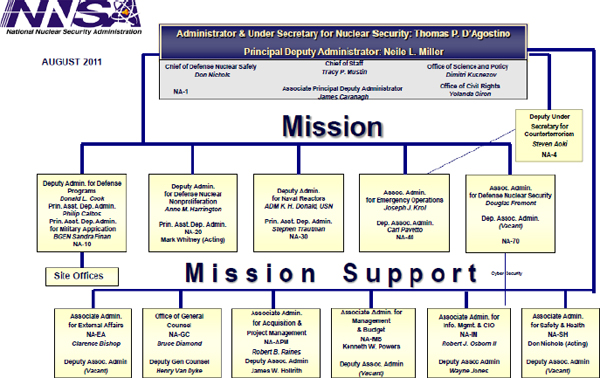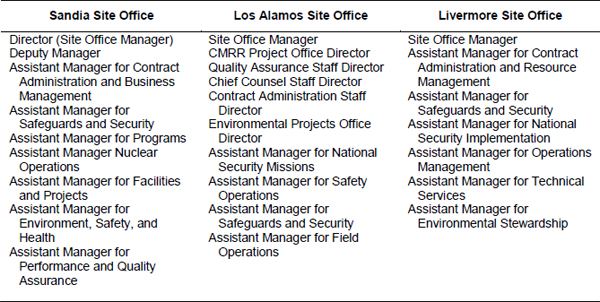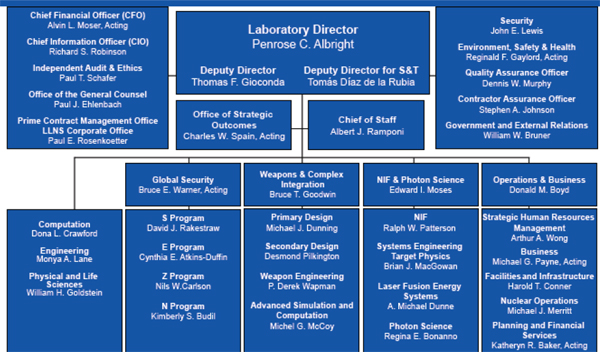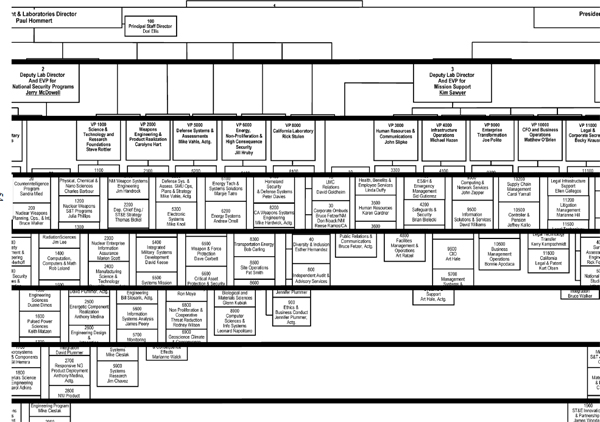D
The Structure of the Management Organizations that Govern the NNSA National Security Laboratories
GOVERNMENT (PRIMARILY DOE/NNSA, INCLUDING SITE OFFICES)
These three laboratories are overseen primarily by NNSA, located in DOE. The primary responsibility lies with the Deputy (NNSA) Administrator for Defense Programs (NA-10), who is responsible both for management/administration of the labs, and for the core programs. The organization of NNSA is shown in Figure D.1. Day-to-day matters are handled through the site office at each location: Sandia Site Office (SSO); Los Alamos Site Office (LASO); and Livermore Site Office (LSO). The site managers report to the Deputy Administrator for Defense Programs (NA-10). The laboratory directors also communicate with (report to) the NNSA Administrator (who is also the Under Secretary of Energy for Nuclear Security), and the Principal Deputy Administrator, and to the Secretary of Energy. On matters related to the stockpile stewardship program, the laboratory directors are responsible to the President, the Secretary of Energy, the Secretary of Defense, and to the Congress.
In addition to NA-10, other NNSA Deputy Administrators deal with the laboratories on substantive matters. The laboratories also do work for the DOE Office of Science, and for other major government entities, primarily DoD, DHS, and DNI. However, only NNSA (particularly NA-10) is directly involved directly in the health and management of the laboratories.
The DOE site offices are important because they are the primary interface between DOE and the laboratories, and the initial point of contact for most matters managerial, contractual, and administrative. The site offices are organizations of significant size (~100 officers are each site office), and somewhat complex organization. Each site manager reports directly to NA-10. However, within each site office some of the officers have other reporting chains in addition to reporting to the site manager. Within each site office, the contract manager is responsible for ensuring that the M&O contractor follows all the terms of the contract, and for evaluating performance under the terms of the contract. This includes the development of performance evaluations plans (PEPs), and the yearly performance evaluation reports (PERs). The yearly award fee, as specified in the contract, depends on the yearly evaluation. While final sign-off on the evaluation and award rests with the NNSA Administrator and Principal Deputy, most of this is worked through the reporting chain that begins with the contract manager at the site office.
Two important indicators of the factors of major importance in the management of the laboratories—at least from the NNSA/DOE perspective—are the organization of the site offices, and the list of factors for evaluation as specified in the M&O contracts and elaborated in the PEPs. The structures of the site offices are reviewed below; the contacts and PEPs are discussed in Appendix D.
Figure D.2 shows the major offices within SSO, LASO, and LSO as listed in the DOE (on-line) telephone directory (http://phonebook.doe.gov/fieldorg.pdf).1Table D.1 compares these by function.
_______________________________
1 These listings are current as of September 15, 2011.

FIGURE D.1 NNSA organizational chart. SOURCE: See http://nnsa.energy.gov/sites/default/files/nnsa/inlinefiles/NNSA%20HQ%20org%20chart%20-%20with%20names%208-11_1.pdf. August 2011.

FIGURE D.2 Major Officers at the three site offices.
TABLE D.1 Comparison of Major Offices at the three Site Offices
| Function | SSO | LASO | LSO |
| Contract administration | Contract Administration and Business Management | Contract Administration | Contract Administration and Resource Management |
| Safeguards and security | Safeguards and Security | Safeguards and Security | Safeguards and Security |
| Environment and health | Environment, Safety, and Health | Environmental Projects | Environmental Stewardship |
| Safety | Environment, Safety, and Health | Safety Operations | |
| Performance and quality assurance | Performance and Quality Assurance | Quality Assurance | |
| Operations | Nuclear Operations | Field Operations | Operations Management |
| National security | National Security Missions | National Security Implementation | |
| Other | Programs | CMRR Project | Technical Services |
| Facilities and Projects | |||
Based on Table D.1, we can observe the following:
1. The three site offices are organized similarly, but not identically.
2. None of the three has a senior officer who is explicitly responsible for scientific/technical quality.
3. Most of the organization at each site office appears to be concerned with overseeing contract management, operations, safety, security, environment, and business matters.
In the course of discussions at site visits—including discussions with the three site managers and other site office officers—and at meetings with other NNSA officials, the committee was told that the site offices are concerned with mission performance and the underlying scientific work, but that is not their primary focus. Moreover, the expertise of most site office officers is in operational and support areas (and in business practices and contract performance), not in science and engineering.
Interagency Oversight
The “Governance Charter for an Interagency Council on the Strategic Capabilities of DOE National Laboratories as National Security Assets” (see Appendix A) creates a mechanism for agencies other than NNSA to participate in the planning, evaluation, and maintenance of ST&E (science, technology, and engineering) at the laboratories. This does not supplant the role of DOE/NNSA as the owner of the laboratories, but it brings organizations that had heretofore been users of the capabilities at the laboratories into a more active role of sustaining the ST&E capabilities.
The charter provides for the creation of a mission executive council consisting of two senior executives from each of the signatory agencies (DOE, DoD, DHS, and DNI). Among other things, the executive council will: (1) review and assess the adequacy of ST&E in areas of cross-cutting interest; (2) identify areas of ST&E needing attention; (3) consider recommendations to close identified gaps; and (4) take actions as necessary and appropriate. This charter does not replace NNSA’s authority, and it does not void or replace any contractual obligations. However, it does provide another, broader, government forum within which to evaluate scientific quality at the laboratories and the relevance of that scientific quality to a broad range of national security missions. It also provides a basis for major government agencies beyond DOE/NNSA to develop a stake in—and therefore a basis for investing in—ST&E at the labs.
This interagency review process is an official review process, but it does not supplant or replace the existing NNSA review process under the terms of the M&O contracts. This interagency process explicitly focuses on ST&E, and not on the much broader range of management issues addressed in the yearly reviews and evaluations under the terms of the M&O contracts as conducted through the site offices.
MANAGEMENT ORGANIZATIONS AT THE LABORATORIES (SNL, LANL, LLNL)
The organizations of the three laboratories are shown in Figures D.3, D.4, and D.5.
M&O Contractors (Sandia Corp., LANS, LLNS)
Each of the three laboratories is managed by a corporation established for the sole purpose of managing that laboratory: Sandia Corporation; Los Alamos National Security, LLC (LANS); and Lawrence Livermore National Security, LLC (LLNS). Each laboratory director is an officer of the respective management corporation. The director of SNL is the president of the Sandia Corporation. The director of LANL is the president of LANS, LLC. The director of LLNL is president of LLNS, LLC. In each case, the director is responsible to a corporate board of governors/board of directors.
Sandia Corporation is a wholly owned subsidiary of Lockheed Martin Corporation. The names of the Sandia Corporation board of directors are not generally publically available.
LANS is owned/governed by four parent corporations: Bechtel National, Inc.; University of California; Babcock & Wilcox Company; URS Energy & Construction, Inc.
LLNS is owned/governed by five parent corporations: Bechtel National, Inc.; University of California; Babcock & Wilcox Company; URS Energy & Construction, Inc.; and Battelle. LLNS is also affiliated with the Texas A&M University system.
LANS and LLNS have the same board chairman and vice chairman and share most of their other governors.
All three organizations include substantive review committees that provide periodic reviews to laboratory management. laboratory management may use some of that review material in preparing its self-evaluation (in preparation for the Performance Evaluation Report as specified by the contract), but these internal reviews are considered confidential “insider” critique, and are generally not shared with NNSA.

FIGURE D.4 Los Alamos National Laboratory. SOURCE: LANL current organizational chart as of June 2011, available at http://www.lanl.gov/organization/docs/current/org_chart.jpg.

FIGURE D.5 Lawrence Livermore National Laboratory. SOURCE: See LLNL current org chart as of July 2011, available at https://www.llnl.gov/images/about/org_chart.pdf.








